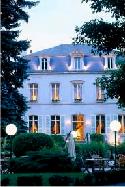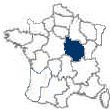|
The
Location of the Region of Burgundy
The
region of Burgundy is located in east-central France, just
southeast of
Paris.
To
the northwest of Burgundy is the region of
Ile-de-France, to its
west is the region of
Centre, to the south-west is
Auvergne, and
to the south is
Rhone-Alpes.
Franche-Comté is to Burgundy’s east and to the north is
Champagne-Ardenne.
The
départements of Burgundy are:
Cote-d’Or [21], Nievre [58], Saone-et-Loire [71] and Yonne
[89].
The
History of the Region
The
Romans had dominated the region now known as Burgundy.
This area formed part of, what the Romans called,
Gallia Lugdunensis (Celtic Gaul).
In 486 the Franks, under
Clovis
I, overthrew Syagrius, the
last Roman governor in Gaul.
During the 5th century
AD,
the Bourguignons, a Germanic tribe, invaded and established the
first kingdom of Bourgogne in France. The kingdom expanded until
it included most of what is now southeastern France and part of
present-day
Switzerland. The Bourguignons were conquered, in
turn, by the
Merovingien rulers of the Franks in 534. They, in turn, were later absorbed into the
Carolingian
Empire.
Under
Clotaire
II’s numerous successors, the Frankish kingdom
became decentralized.
Royal
power gradually degenerated into the noble’s exercise of
feudal control over most of the land. The most important of
these families was the Carolingian.
Charles Martel, as the
Carolingian ruler of the Frankish kingdom
of Austrasia [in present northeastern France and southwestern
Germany], extended the frontiers of the kingdom to the east.
In 732, he repelled the Moors in a decisive battle fought
at a site between
Tours and
Poitiers.
In 843, Burgundy was divided between
Charles I of France (later
Charles II, Holy Roman emperor) and his brother, Emperor Lothair
I. In 879 the
kingdom of Provence, or Cisjurane Burgundy, was organized in the
south, and in 888 the kingdom of Trans-Jurane Burgundy was
created in the north. Two other divisions, the duchy of Burgundy
(which had been a part of the first kingdom of Burgundy) and the
Free County of Burgundy, or
Franche-Comté, were also
established in the 9th century.
In 933 the two kingdoms were united as the second kingdom of
Burgundy, with the capital at
Arles. In 1033 the kingdom was
annexed by Conrad II, Holy Roman emperor.
Until 1361 the duchy of Burgundy was ruled by the house
of
Capet. After 1363, the duchy was ruled by
Philip the Bold of France
and his successors, the dukes of Burgundy.
In 1378, Burgundy [Also known as the kingdom of Arles] was ceded
to France and the kingdom ceased to exist as a separate state. In 1430 the duchy, as well as the territories known
historically as the Low Countries, became part of Burgundy.
By the middle of the 15th century the duchy of Burgundy
dominated French affairs. The antagonism between the dukes of
Burgundy and the kings of France reached a climax in 1465, when
Charles the Bold, the last duke, attempted to restore the
kingdom of Burgundy.
The
struggle ended in 1477 during a battle near
Nancy in which
Charles was killed. A
dispute over possession of the ducal territories developed
subsequently, and a large portion of the territory, which was
known as the Circle of Burgundy, became part of the Holy Roman
Empire. The rest of the duchy was a province of France from 1678
until the French Revolution in 1789.
Subsequently, the province was divided into the
departments of Ain, Côte-d'Or, Saône-et-Loire, and part of
Yonne.
In subsequent centuries, Burgundy was successively part of the
dominions of the
Carolingian kings, part of the second
Bourguignon kingdom of
Arles, and a possession of the counts of Vienne, whose title, Dauphin, gave the region its name.
In 1349, the last Dauphin of Vienne sold the region to
France. Thereafter,
the title ‘Dauphin’ was given to the eldest sons of the
French kings. The Dauphins ruled the region as a separate
province until 1457 when Dauphiné was incorporated into France.
The
Architecture of Burgundy
The basilican plan, used in earlier
cathedrals, needed elaboration to accommodate a new liturgy.
The essential symbol of the cross was incorporated in the
form of transepts, a cross axis (perhaps borrowed from
Byzantium) that served to identify the monks’ choir, as
distinct from the public’s nave. Beyond the choir, in a semicircular apse girded by the
ambulatory (a semicircular extension of the aisles), stood the
main altar, the focal point of the building.
Sub altars were placed in the transepts and in the
ambulatory. Narthexes,
vestibules and reception areas, for pilgrims, were placed at the
nave entrances.
The
Benedictine and Cistercian monks popularized, in the eleventh
century, the barrel-vaulted, three-aisled basilica type church
in Burgundy. An
example of the Cistercian approach is the abbey of Citeaux near
Nuits-Saint-Georges.
The
Benedictines’ design is found at Cluny.
These two Bourguignon building methods served as
archetypical prototypes throughout Europe. The Church of Saint Philibert, at Tournus, is an eleventh
century example of this architecture.
The church is remarkable for its two-storied,
groin-vaulted entry porch.
Unlike
other French churches of the period, Saint Philibert used
transverse arches to support a series of barrel-vaulted naves.
At the ends of the vaults, the naves had windows that
were high in the vertical plane.
As seen in Sainte Madeleine, in Vezelay, the groin vault
became the popular solution.
This answer can also be seen in the Worms Cathedral in
Germany.
The Chateau at Ancy-le-Franc, at Tonnerre in Burgundy, is
another example of Burgundy’s architecture.
The chateau is built around three sides of a courtyard.
The Italian architect Sebastiano Serlio designed the
chateau in about 1546. Serlio brought an Italian influence to French architecture,
which at that time, was
overwrought with detail. The plain surfaces and simple contours
were the direct result of classical influence on Serlio’s
work.
The
Economy
The region is known for its wines and haute-cuisine.
-
The
Agriculture
The vineyard of the Côte d'Or, the Côte de
Beaune and Châblis yield some of the world's most venerated
wines. The
region produces snails, Bresse chicken and Charolais
beef.
-
The
Industry
Products
include machinery, electronic equipment, processed food
(notably Dijon mustard and gingerbread), brandy, and
fabricated metal.
The
Gastronomy
- Wine
- Pommard
- Savigny-les-Beaunes
- Meursault
- Cheese
- Cuisine
- Boeuf
Bourguignon
Bacon, salt & pepper, onions,
carrots, shallots, butter, lemon, flour, garlic, red
Burgundy, celery & mushrooms
- Poulet
de Bresse en civet
- Escargot
a l’ail
Snails, salt &
pepper, butter and parsely
- Soupe
d’escargots au Meursault,
- Oeufs
a la Bourguignonne
Eggs, red Burgundy,
onion, garlic, flouer, salt & pepper
- Poussin
a la Moutarde
A small chicken, Dijon
mustard and crème fraiche
-
Coq au
Vin
Capon, butter, bacon,
onions, mushrooms, flour, garlic, red Burgundy
|



